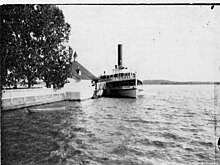 View of the Mount Vernon wharf area and dock, circa 1930s View of the Mount Vernon wharf area and dock, circa 1930s | |
| Founded | c. 1765 |
|---|---|
| Founder | George Washington |
| Headquarters | Mount Vernon, Alexandria, Virginia |
| Products | Herring, shad, striped bass, catfish, perch, crabs, oysters, clams |
George Washington's Fishery, also referred to as the Mount Vernon Fishery, was an active part of the original Mount Vernon plantation, and an early seafood business in Colonial America.
History
George Washington inherited Mount Vernon in 1754. In an effort to diversify his sources of income from the estate due to erosion and other soil problems, Washington had begun small fishing operations by 1765. Washington built and operated a fishing fleet and fishery on multiple sections of the Potomac River including "Posey's Ferry," the wharf, and near Sheridan Point in the River Farm area of the estate. Washington wrote of Mount Vernon that the ten miles of shoreline at his estate were “one entire fishery.”
The fishery was originally intended to help feed the hundreds of slaves who lived on the Mount Vernon plantation, but Washington soon realized that the fishery would also provide a lucrative business opportunity if he began exporting fish and other seafood. The great majority of the work on the fishery was performed by enslaved African Americans. To conduct commercial fishing, Washington ordered seine nets that were twelve feet high and several hundred feet wide. Dropped by two workers in a rowboat, the seine nets formed a barrier that would catch thousands of fish and shellfish, which enslaved workers collected in baskets as the net was pulled onshore.
The fishery was a highly profitable enterprise for Washington. The business caught and harvested close to one million herring annually, in addition to shad, striped bass, catfish, perch, crabs, oysters, and clams. The fishery's herring in particular soon developed an international reputation among buyers for their quality and taste. The fishery often yielded higher profits than other crops raised on Mount Vernon. The business sold seafood locally and regionally, and shipped barrels of salted fish to the West Indies.
The fishery included a small fleet of its own fishing vessels, including a schooner that was built in 1765 by enslaved carpenters, and transported herring and other seafood to various locations, including Antigua. Washington also briefly acquired a brig he called the Farmer which carried fish to destinations including Jamaica and Portugal in the mid-1770s. Prior to the Revolutionary War, Washington's dealings with the British government through his fishery business left him with a negative impression due to imperial trade policies that forbade him from importing his desired fish-curing salts from Portugal.
During his presidency from 1789 to 1797, Washington was not heavily involved in his fishery business, but he did direct the manager of his fishery business, William Pearce, to sell surplus seafood and was involved in the sale of fish and pricing negotiations with merchants. In 1793, Washington wrote that the banks of the Potomac River were "well-stocked with various kinds of fish in all seasons of the year, and in the Spring with shad, herring, bass, carp, perch, sturgeon, etc., in great abundance."
See also
References
- "George Washington's Fishery". Mental Floss. 2013-03-21. Retrieved 2023-10-02.
- ^ "George Washington's Fisheries Historical Marker". www.hmdb.org. Retrieved 2023-10-03.
- "Mount Vernon Distillery and Fishery Ledger". Encyclopedia Virginia. Retrieved 2023-10-03.
- "Hunting and Fishing". George Washington's Mount Vernon. Retrieved 2023-10-03.
- "Tobacco". George Washington's Mount Vernon. Mount Vernon Ladies' Association.
- ^ "George Washington's Fisheries Historical Marker". www.hmdb.org. Retrieved 2023-10-03.
- ^ "Fishing Operations at Mount Vernon". George Washington's Mount Vernon. Retrieved 2023-10-03.
- "Founders Online: From George Washington to Anthony Whitting, 14 November 1792". founders.archives.gov. Retrieved 2023-10-03.
- “From George Washington to Arthur Young, 12 December 1793,” Founders Online, National Archives, https://founders.archives.gov/documents/Washington/05-14-02-0337 .
- Life and Times of George Washington. Ransdell, Incorporated, Printers. 1932.
- "Food". George Washington's Mount Vernon. Retrieved 2023-10-03.
- Niemcewicz, Julian, Under the Vine and Fig Tree: Travels Through America in 1797-1799, ed. Metchie J. E. Budka (Elizabeth, NJ: Grassmann Publishing Company, 1965), 106.
- "The History of American Shad in Virginia". dwr.virginia.gov. Retrieved 2023-10-03.
- ^ Mares, William J.; Mares, Bill (1999-01-14). Fishing with the Presidents: An Anecdotal History. Stackpole Books. ISBN 978-0-8117-2768-6.
- Grizzard Jr., Frank E. (2002-05-22). George Washington: A Biographical Companion. Bloomsbury Publishing USA. ISBN 978-1-57607-558-6.
- Rees, James; Spignesi, Stephen J. (2007-01-22). George Washington's Leadership Lessons: What the Father of Our Country Can Teach Us About Effective Leadership and Character. John Wiley & Sons. ISBN 978-0-470-08887-6.
- Dalzell, Robert F.; Dalzell, Lee Baldwin (2000-02-24). George Washington's Mount Vernon: At Home in Revolutionary America. Oxford University Press, USA. ISBN 978-0-19-513628-9.
- ^ "Mount Vernon Fisheries". George Washington's Mount Vernon. Retrieved 2023-10-03.
Further reading
- Leach, Donald (2001), George Washington: Waterman-Fisherman, 1760-1799, Yearbook of the Historical Society of Fairfax County: 28, 1-28.
- Wharton, James (1952), Washington's Fisheries at Mount Vernon, The Commonwealth: 11–13, 44.
External links
Categories:- George Washington
- Colony of Virginia
- History museums in Virginia
- Museums in Fairfax County, Virginia
- National Register of Historic Places in Fairfax County, Virginia
- Seafood companies of the United States
- Organizations established in 1765
- 1765 establishments in the Colony of Virginia
- Fish processing companies